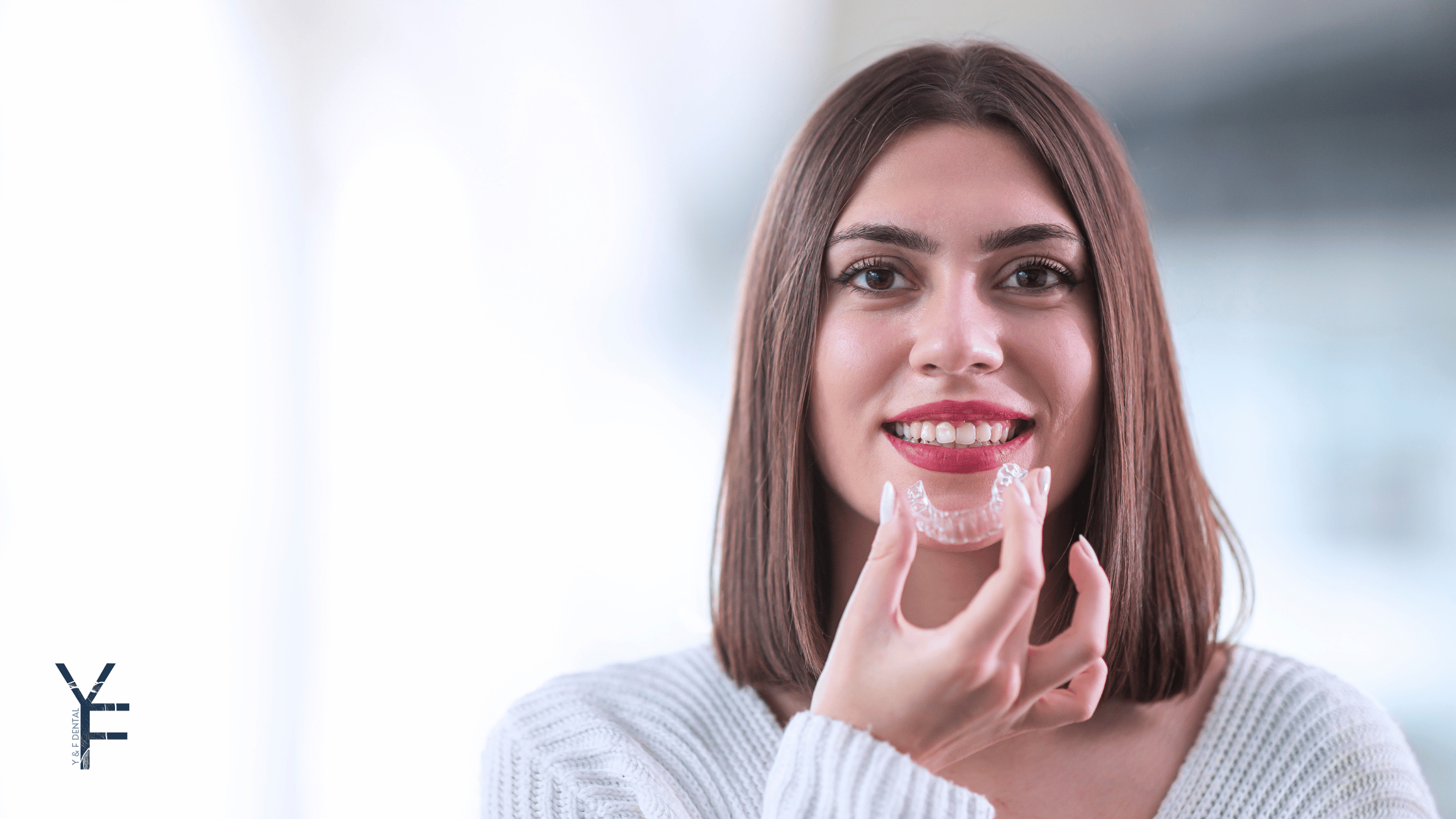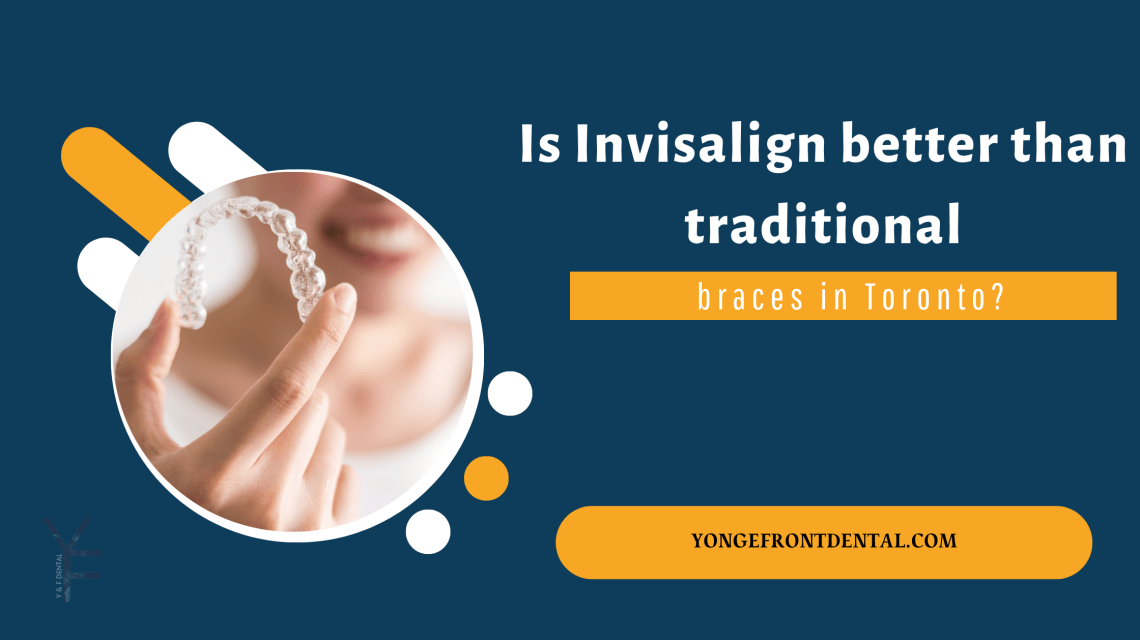When it comes to straightening teeth, Invisalign and traditional braces are two of the most common orthodontic treatments available. Both options help improve oral health, correct bite issues, and create a more confident smile. However, they differ in terms of appearance, comfort, maintenance, and effectiveness.
For those in Toronto considering orthodontic treatment, understanding these differences can make it easier to choose the best solution. At Yonge and Front Dental, we offer both Invisalign and traditional braces, ensuring patients receive the most suitable treatment for their dental needs.
What is Invisalign?
Invisalign is a modern orthodontic treatment that uses clear, removable aligners to gradually shift teeth into the desired position. These aligners are custom-made for each patient and replaced every few weeks to continue the adjustment process.
Key Features of Invisalign
- Nearly invisible aligners for a discreet treatment
- Custom fit for comfort and effectiveness
- Removable design for easier eating and oral hygiene
- Gradual adjustments without the need for wires and brackets
What are Traditional Braces?
Traditional braces have been used for decades to correct a wide range of dental misalignments. They consist of metal or ceramic brackets that are bonded to the teeth, with a wire running through them. Over time, the orthodontist adjusts the wire to guide the teeth into alignment.
Key Features of Traditional Braces
- Fixed placement for continuous pressure and effective movement
- Suitable for severe misalignment and bite correction
- Available in metal or ceramic options

Comparison: Invisalign vs. Traditional Braces
Choosing between Invisalign and traditional braces depends on several factors, including lifestyle, oral health needs, and budget.
Appearance
One of the biggest reasons patients opt for Invisalign is its discreet design. The clear aligners are barely noticeable, making them ideal for adults and teenagers who prefer a subtle orthodontic solution.
On the other hand, traditional braces are more visible, although ceramic braces provide a less noticeable alternative. Some patients enjoy personalizing their braces with colored bands, turning them into a fun accessory rather than a drawback.
Comfort and Fit
Invisalign aligners are made from smooth plastic, reducing the risk of irritation to the gums and inner cheeks. Since there are no wires or brackets, patients experience less discomfort compared to traditional braces.
Braces, however, can cause minor irritation, especially in the initial adjustment period. The brackets and wires may occasionally cause soreness, particularly after tightening appointments. Orthodontic wax and over-the-counter pain relievers can help alleviate any discomfort.
Maintenance and Oral Hygiene
Maintaining good oral hygiene is easier with Invisalign since the aligners are removable. Patients can brush and floss normally without maneuvering around brackets or wires. However, aligners must be cleaned regularly to prevent bacteria buildup.
With traditional braces, cleaning requires extra effort. Food particles can get trapped between brackets and wires, increasing the risk of plaque buildup. Patients must use special brushes or floss threaders to ensure thorough cleaning.
Eating Restrictions
Invisalign users can enjoy their favorite foods without restriction since the aligners are removed before meals. There is no need to avoid crunchy or sticky foods, which can be an issue with braces.
Braces come with dietary limitations. Hard foods like nuts, popcorn, and raw carrots can damage brackets, while sticky foods like gum and caramel can get stuck in the wires. Patients must be mindful of their eating habits to prevent breakages and additional orthodontic visits.
Effectiveness and Treatment Duration
While both Invisalign and braces can correct dental misalignment, their effectiveness depends on the complexity of the case.
- Invisalign works well for mild to moderate misalignment, including spacing issues and minor bite problems
- Braces are suitable for all levels of misalignment, including severe crowding, rotations, and complex bite issues
The average treatment time for Invisalign ranges from 12 to 18 months, while braces typically require 18 to 24 months. However, the duration varies based on individual cases.
Cost and Insurance Considerations in Toronto
The cost of Invisalign and braces depends on the complexity of the treatment, duration, and clinic location.
- Invisalign generally costs between 3,500 and 8,500 dollars in Toronto
- Traditional braces range from 3,000 to 7,500 dollars, with metal braces being the most affordable option
Many dental insurance plans cover both treatments, but coverage amounts may vary. At Yonge and Front Dental, we help patients explore financing options to make orthodontic care more accessible.

Who Should Choose Invisalign?
Invisalign is an excellent choice for:
- Adults and teenagers who want a discreet option
- Patients with mild to moderate misalignment
- Individuals who prefer fewer dietary restrictions
- Those who can commit to wearing aligners for at least 22 hours a day
Who Should Choose Traditional Braces?
Braces are ideal for:
- Patients with severe misalignment or bite issues
- Children and teenagers who may not be responsible enough for removable aligners
- Individuals looking for a cost-effective solution
- Those who do not mind the appearance of braces
Why Choose Yonge and Front Dental for Orthodontic Treatment?
At Yonge and Front Dental, we provide personalized orthodontic solutions tailored to each patient’s needs. Our team offers expert guidance on whether Invisalign or traditional braces are the best fit for your smile goals.
What Sets Us Apart?
- Experienced orthodontic specialists who customize treatment plans
- State-of-the-art technology for precise results
- Affordable financing options and insurance assistance
- A comfortable and welcoming environment for stress-free dental care

Conclusion
Both Invisalign and traditional braces have unique benefits, making them excellent choices for achieving a straighter smile. The right option depends on factors like treatment complexity, budget, and lifestyle preferences.
If you are unsure which treatment is best for you, our team at Yonge and Front Dental in Toronto is here to help. Schedule a consultation today to discuss your options and take the first step toward a healthier, more confident smile.


